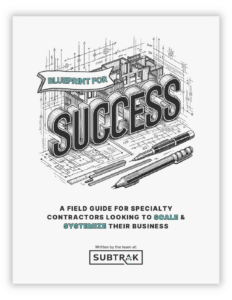Most specialty construction company owners know that to keep their revenue growing, they need to either land a higher number of projects or tackle larger, more expensive ones. But taking on increasingly large projects might not be feasible or desirable for a number of reasons, including lack of sufficient staff or proper cash flow to finance such ventures.
In cases such as these, the most prudent move a contractor can make is to improve the efficiency of their internal processes and finish a higher number of projects in the same amount of time. Fine-tuning your project closeout operations will cut down on the office hours spent chasing money and will ensure that you are paid on time and in full.
Contractors often make the mistake of letting their money linger. They figure: “The work is done. We’re owed the money, but we’ll collect it eventually.” But that mentality is the absolute wrong way to look at this situation. Your final payment often represents a large chunk of the overall profit on a project. Don’t let your customers hold onto it!
If you don’t make collecting retention money a priority, you’ll fall victim to one of nature’s most immutable laws: People forget. The work is done, the project anxiety has subsided, so it’s natural for your employees to want to let their foot off the gas. They tend to forget about closing things out completely and instead move on to the next project that is underway and requiring their attention. But the fact is that the longer this final 5–10% payment sits in your customers bank account and not yours, the harder it becomes to collect.
Fortunately, there are several ways a contractor can improve their closeout process to collect their money faster:
Know What Needs to Happen — While each project can have minor differences, most specialty contractors perform work that requires a largely uniform closeout process. Whether you regularly submit finaled permits, signed punch lists, workmanship warranties, as-built drawings, O&M manuals, online review requests, or any other pertinent documentation, the first step is for your staff to know exactly what needs to happen to collect final payment. Creating a standardized checklist for your team will give you peace of mind that no task is being overlooked.
A great way to ensure that each closeout task is completed to a high standard (and particularly for new employees) is to document the desired process for each task in a collection of Standard Operating Procedure (SOP). Well written SOPs are worth their weight in gold. By documenting your closeout processes in a step-by-step manner, employees will know exactly how you want the tasks completed. This will limit the questions they have to ask, and increase their efficiency and confidence in completing each task.

Make a Plan to Complete Each Task — After you know what needs to happen, you need to make sure the right people are making it happen. Giving employees clear accountabilities with time-bound deadlines is the key to getting your projects closed out efficiently.
For example, let’s say you need the Superintendent to complete the punch list items, the Project Manager to complete the as-builts, and the Project Coordinator to order the manufacturer’s warranty. Without clearly communicating these responsibilities and deadlines to each member on your team, tasks will be disjointed and take longer to complete, because employees will be completing them on their own individual schedules.
By communicating the specific closeout accountabilities to each employee, and when they must be completed, your team is more likely to complete their tasks on time and in unison.
Track your Success to Improve Efficiency — Once you have decided what needs to happen, who needs to do it, and when it needs to get completed by, your next step to improving closeout efficiency requires you to track the average time it takes to collect final payments. From the last day of onsite work to the day final payment is received, is your company collecting payment efficiently, or are they letting things fall through the cracks?
Tracking not only the company’s overall closeout efficiency, but also the efficiency of your individual team members’ task completion, can provide insight into which specific processes must be improved. Not to mention, if an employee is consistently missing deadlines and slowing down the process, it is important for managers to be alerted so that they can address the situation.
Reliably knowing how long it takes your company to close out a project and receive final payment will help you forecast cash flows more accurately, and allow your company to expand in a predictable and confident manner.
We made Subtrak to help with this exact problem. Get in touch with us today so we can show you how we can help your company improve the efficiency of your core processes, including project closeout. By getting your team on the same page, you’ll collect final payments faster and take a giant leap toward making your company more predictable, more profitable, and more valuable!




